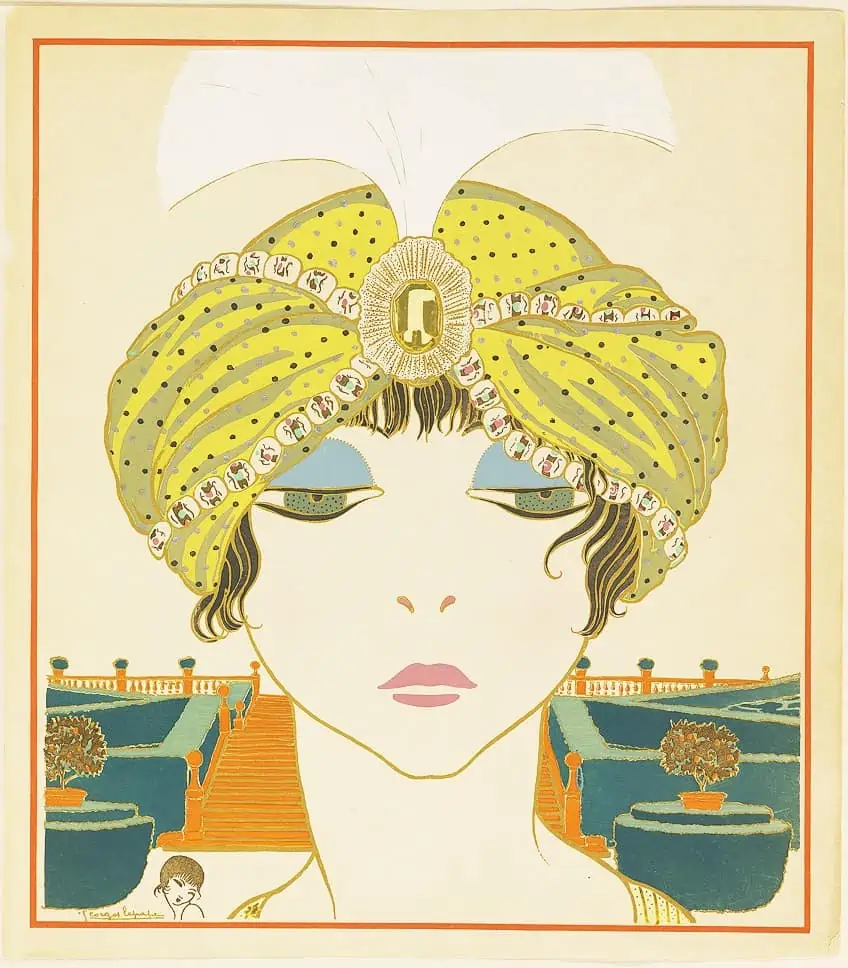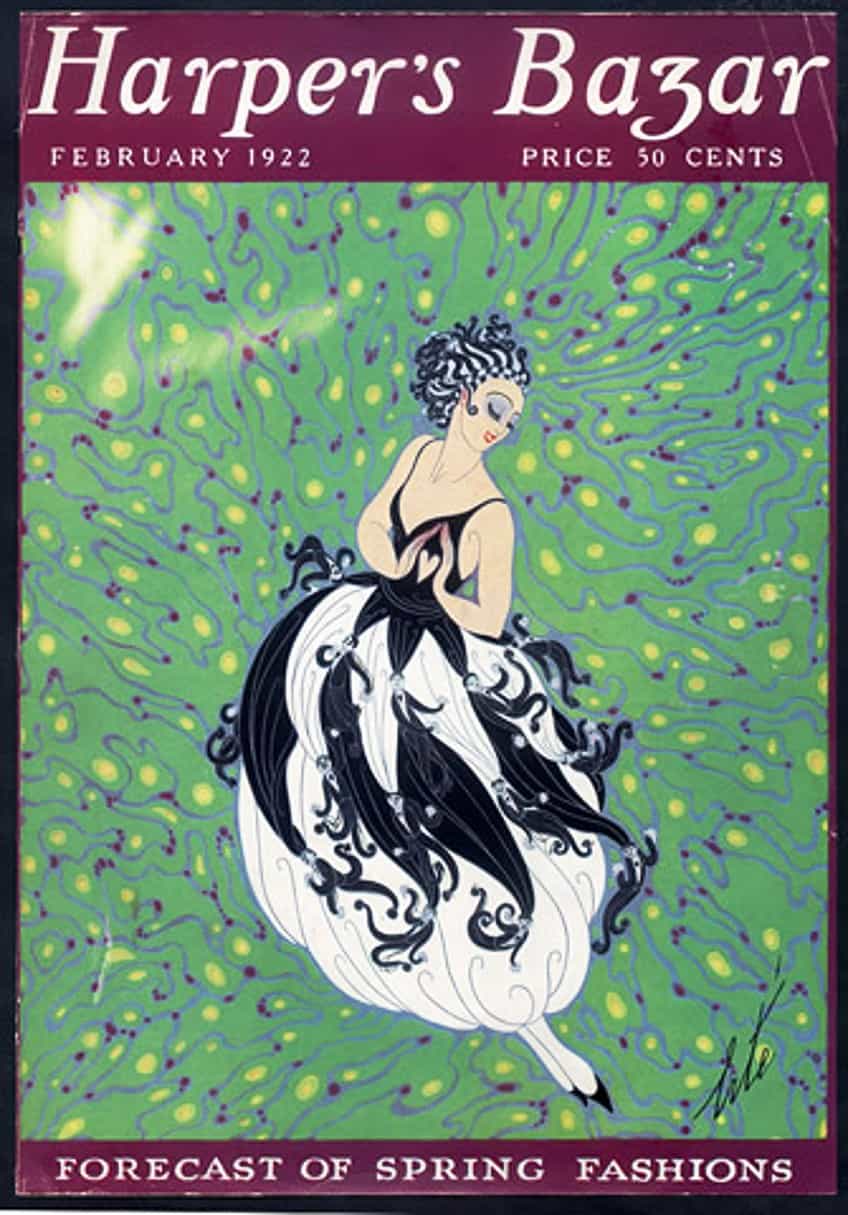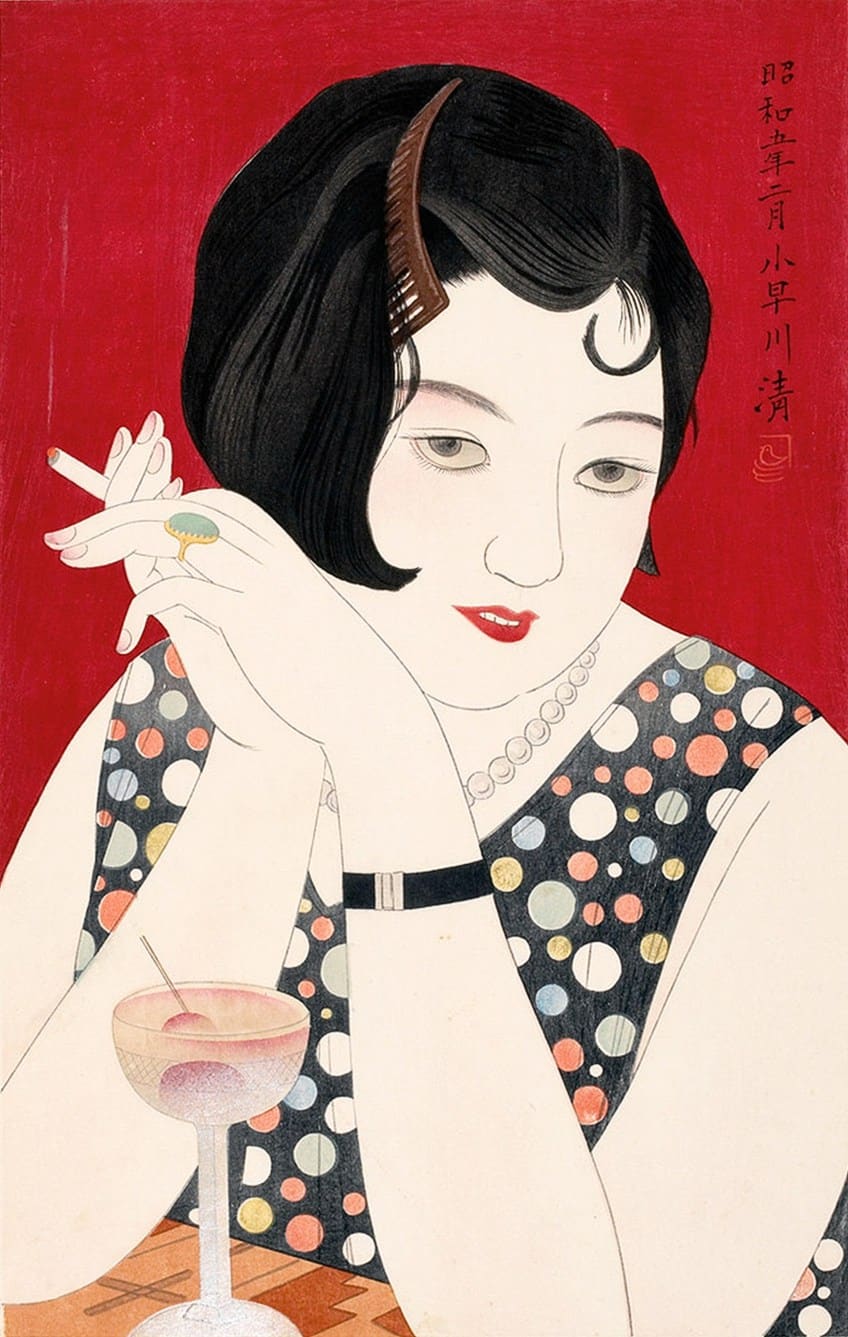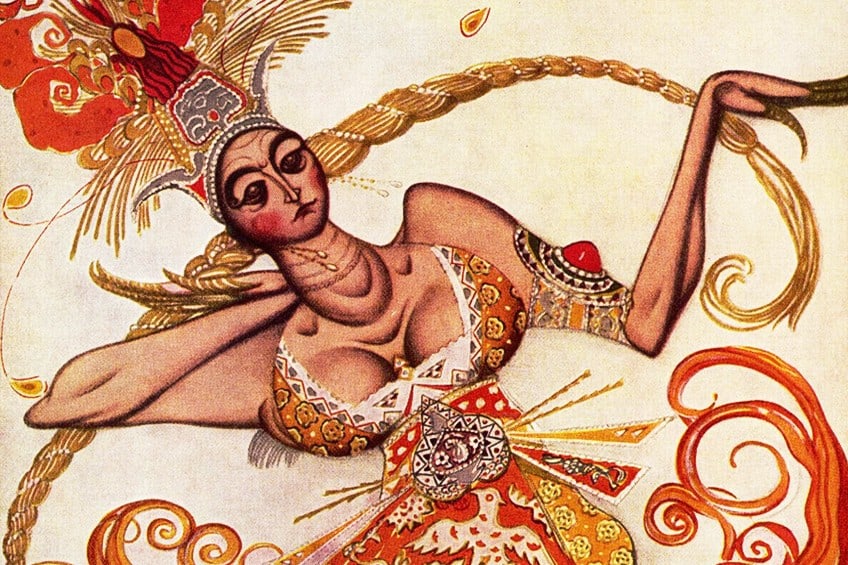Famous Art Deco Paintings – Looking at Famous Art Deco Art
The 1920s Art Deco style was so influential that it could be found everywhere from hood ornaments to fashionwear. However, for this article, we will be focusing on famous Art Deco paintings, such as Art Decor portraits and posters. These famous Art Deco artworks embody the glamour and elegance of the 1920s era.
Contents
- 1 Famous Art Deco Paintings
- 1.1 Le Miroir Rouge (1913) by Georges Lepape
- 1.2 Costume for the Firebird (1913) by Léon Bakst
- 1.3 Pivolo Aperitif Aux Vins De France (1924) by A. M. Cassandre
- 1.4 Mariage d’Amour Mariage de Raison (1927) by Romain de Tirtoff
- 1.5 Nord Express (1927) by A.M. Cassandre
- 1.6 Autoportrait (Tamara in a Green Bugatti) (1929) by Tamara De Lempicka
- 1.7 Young Lady With Gloves (1930) by Tamara de Lempicka
- 1.8 Tipsy (1930) by Kobayakawa Kiyoshi
- 1.9 Study from the Chariot of Poseidon Mural for the SS Normandie (1935) by Jean Dupas
- 1.10 American Progress Murals (1937) by Jose Maria Sert
- 1.11 Symphony in Black (1967) by Erté
- 2 Frequently Asked Questions
Famous Art Deco Paintings
Art Deco art, like Art Nouveau, is a modernist art style that aims to integrate artistic elements into functional objects. 1920s Art Deco art embodied the glamor, elegance, and unwavering trust in technical advancement that characterized the years following World War I.
Le Miroir Rouge (1913) by Georges Lepape
| Artist | Georges Lepape |
| Date Completed | 1913 |
| Medium | Pochoir with metallic paint, print |
| Location | The Mitchell Wolfson Jr Collection |
Georges Lepape was a well-known Art Deco artist and designer. His Art Deco artworks, like that of many other Art Deco painters, are influenced by styles and interests from all over the world, particularly Persian miniatures, Japanese art, and Ballet Russes.
This Art Deco portrait depicts a woman from Japan in the style of a Noh mask.

The image of this stylish, luxurious woman staring at her reflection is created by a few distinct lines and colors. She is portrayed with matching lipstick and fingernails, wearing various colored earrings and rings. The curvilinear aesthetic, the refinement, and the subject choice are all Art Deco art characteristics.
Costume for the Firebird (1913) by Léon Bakst
| Artist | Léon Bakst |
| Date Completed | 1913 |
| Medium | Gouache, watercolor, metallic paint |
| Location | Museum of Modern Art |
Léon Bakst is one of the most essential theatrical costume designers of the early 1900s. His artwork had a significant impact on early Art Deco art themes. The brilliant colors, geometrical design, “foreign” imagery, and rich and strong arrangement are all apparent Art Deco components in this piece.
The painting features a female performer dressed in an ornate yellow dress with colorful themes and stylized characters like flowers and birds.

The dancer is wearing an ornate headpiece with rich shades of turquoise, red, and orange. The fabrics and patterns depicted on the textiles have an Eastern look to them, demonstrating a sign of the Orientalism influence on Art Deco artworks.
Pivolo Aperitif Aux Vins De France (1924) by A. M. Cassandre
| Artist | A.M. Cassandre |
| Date Completed | 1924 |
| Medium | Poster |
| Location | Multiple prints |
This poster was made in 1924 by A. M. Cassandre, one of the most prominent poster painters and graphic designers in the Art Deco style. It earned a prize at the Exposition Internationale des Arts in Paris the same year, which was an event that was largely recognized as having established the Art Deco art style on a worldwide scale.
Cassandre is well recognized for his distinct, elegant, and minimalist advertisements for tourism, furniture, and alcohol brands.
He is also regarded as a modern graphic design innovator, with breakthroughs such as the creation of new, characteristically Art Deco fonts, some of which were influenced by prominent painters such as Max Ernst and Pablo Picasso. A stylized, monochrome bird perches behind a little glass of honey-colored liquor in this poster.
Though both pictures are figurative, they are reduced in a way comparable to Cubist deconstruction: things are broken down into simple, overlapping geometric patterns.
To establish a harmonious interaction between components in this composition, the artist focuses on a restricted palette of gray, black, and a small range of cold tones contrasting with warm ones – the royal blue of the lettering paired with the attractive amber tint of the aperitif.
Mariage d’Amour Mariage de Raison (1927) by Romain de Tirtoff
| Artist | Romain de Tirtoff |
| Date Completed | 1927 |
| Medium | Gouache on cardboard |
| Location | Cover design for Harper’s Bazaar |
Because the majority of Americans preferred to read magazines and watch movies rather than visit museums and art galleries, the fact that Erté’s art was so ubiquitous in the popular culture helped the Art Deco style to become more broadly shared rather than staying primarily in the realm of a rich few.
A sitting female figure with bobbed hair holds a spherical orange blossom in her right palm in this Harper’s Bazaar cover illustration.

She gently holds an enormous strand of pearls stacked in an exquisite deep red box in her left hand. In this visual metaphor of marriage, she is wondering whether to marry for love or money. Erté was also inspired by Egyptian art, iconography from ancient Greek ceramics, and other ancient sources.
His is a more exquisite and curved interpretation of the streamlined Art Deco style, a less abrupt divergence from the previous Art Nouveau style’s more intricate shapes and distinctive serpentine lines.
Nord Express (1927) by A.M. Cassandre
| Artist | A.M. Cassandre |
| Date Completed | 1927 |
| Medium | Color Lithograph |
| Location | The Modernism Collection, Minnesota |
While new transportation technology brought about significant change and disruption, it was also regarded as an exhilarating achievement. Cassandre depicts the train’s modernity with clean and simple outlines, highlighting its power by having viewers look up at its soaring iron form from a track-level viewpoint.
He also accentuates the velocity of the train by using straight lines that recede into the distance swiftly.
Cassandre’s jubilant poster may have influenced the public’s perception of rail travel as more than simply a mode of transportation. Passengers may instantly escape the monotony of everyday life and embrace the opportunities provided by modernization.
Autoportrait (Tamara in a Green Bugatti) (1929) by Tamara De Lempicka
| Artist | Tamara de Lempicka |
| Date Completed | 1929 |
| Medium | Oil on panel |
| Location | Private Collection |
A German fashion magazine, Die Dame, commissioned the work as a celebration of women’s freedom and power and it is considered one of the most famous art Deco artworks ever made. Tamara de Lempicka was recognized at that time for her art deco portraits of wealthier people and nobility.
De Lempicka is depicted in this Art Deco artwork driving a Bugatti. She’s dressed in leather gloves, a whitish-gray scarf, and a matching helmet.
Her scarf appears to move as a result of the strong wind generated by the moving vehicle. De Lempicka depicted herself as a strong and independent lady, the embodiment of luxury and inaccessibility; therefore, this Art Deco portrait became an icon of its time. The Cubism style has influenced the geometric nature of her composition. Her style is sharp and beautiful, with crisp and precise lines that are typical of the sleek Art Deco art style.
The end result is a beautiful, alluring piece of art that has become an emblem of modern, free, and independent women.
Young Lady With Gloves (1930) by Tamara de Lempicka
| Artist | Tamara de Lempicka |
| Date Completed | 1930 |
| Medium | Oil on plywood |
| Location | Musée du Luxembourg, Paris |
This famous Art Deco art piece features a classically elegant woman with a green gown, matching white gloves, a hat, and vibrant red lipstick. Although the artist avoids the more extended abstraction of the style, the acute linearity, fragmented planes of green cloth, flat gray backdrop, and dramatic interaction of shadow and light on her face demonstrate the major impact Cubism had on the Art Deco aesthetic.
The majority of her paintings are figurative, with strong colors and fine, clear lines that are typical of elegant and beautiful Art Deco artworks.
Another aspect of the Art Deco art style that Tamara de Lempicka’s work embodies is refined sensuality. In the painting, the young woman’s silk garment clings to the lines of her body in a sensual way, emphasizing her waistline and breasts.
In fact, when it was initially shown at the Salon des Independants in Paris in 1932, the sexually suggestive aspect of this artwork provoked criticism.
Tipsy (1930) by Kobayakawa Kiyoshi
| Artist | Kobayakawa Kiyoshi |
| Date Completed | 1930 |
| Medium | Woodblock print |
| Location | Honolulu Museum of Art Accession, Hawaii |
Tipsy is Japanese artist Kobayakawa Kiyoshi’s Art Deco portrait. He portrays a modern lady with red lipstick, dilated pupils, a cigarette in her fingers, and a drink in front of her. The bright red in the background contrasted with her light skin.
The painting depicts the lifestyle of a self-sufficient woman who enjoys the nightlife. The 1920s Art Deco aesthetic was extremely popular and extended throughout the world, even in Japan.

Her short haircut, which was fashionable at the time, accentuated the sense of independence even more. The emergence of the style internationally was indicative of not only a new art style, but also a more modern outlook as far as female autonomy was concerned, and Art Deco art would often portray this social shift.
Study from the Chariot of Poseidon Mural for the SS Normandie (1935) by Jean Dupas
| Artist | Jean Dupas |
| Date Completed | 1935 |
| Medium | Graphite, charcoal, and ink |
| Location | Christian Grandin, Paris |
This preparatory design depicts a portion of one of the most important Art Deco works: a mural design for the Grand Salon of the SS Normandie, one of the most luxurious ocean liners. The entire artwork was decorated with 400 meters of glass.
Jean Dupas, one of the most prominent and trendy designers of the period, used a method called verse églomisé to achieve a mirror-like brightness.
This method required first painting on the back of plate-glass boards in black and other pastel colors, then applying silver and gold over the paint, and lastly attaching a canvas to the back. The end product was a spectacular, opulent arrangement that stands as one of the finest representations of French Art Deco aesthetics.
American Progress Murals (1937) by Jose Maria Sert
| Artist | Jose Maria Sert |
| Date Completed | 1937 |
| Medium | Mural |
| Location | Main Lobby of 30 Rockefeller Plaza |
The renowned mural artist Jose Maria Sert was contracted in 1937 to create artistic images for the Rockefeller Center’s main lobby, a modernist Art Deco art masterpiece set to open in 1939. Diego Rivera was originally commissioned to produce the paintings, but he insulted the Rockefeller family by featuring Lenin in his design for the piece, thus the original mural was destroyed and the project was given to Sert instead.
The piece shows Art Deco’s signature blend of classical and modern elements. The picture contains allegorical and traditional painting themes such as the muses of literature and dance.
It is also a celebration of the individuals and ideals that have contributed to contemporary American society, with historical icons such as Ralph Waldo Emerson and Abraham Lincoln included. It is a statement of America’s forward-thinking advancements in all aspects of the sciences and arts and it celebrates technological advancement and themes of man’s ability to dominate the world in a distinctly American style.
The piece conveys a strong nationalist sentiment, akin to numerous public murals created in the United States between World Wars. Murals are created to work in tandem with the room’s architecture, allowing great art and design to blend smoothly, a trait that became distinctively Art Deco. In this case, the depicted figure of Atlas seems to be sustaining the room’s ceiling by marching between two supporting pillars.
These blocky forms were typical of the Art Deco style; whereas Art Nouveau stressed the sensual curve, Art Deco may be considered to highlight the angular and, at most, the slightly curved.
Symphony in Black (1967) by Erté
| Artist | Erté |
| Date Completed | 1967 |
| Medium | Lithograph |
| Location | Multiple Prints |
Erté began his career as a costume designer at the Parisian couturier Paul Poiret’s studio, where he dressed performers and movie stars such as Joan Crawford and Josephine Baker and designed theatrical sets for Broadway musicals and Hollywood movies.
Erté’s renowned picture depicts a beautiful, elegant woman carrying a leashed black dog.
The body is stylized in various ways; the slim shape contrasts with the lavish, thick, and fluffy jacket and headgear. What sticks out is the woman’s inherent confidence. This illustration perfectly captures the beauty and refinement of Art Deco artworks.
As the developing ideas of modernity took hold of the globe, the Industrial Revolution served as a major source of inspiration for artists. Suddenly, artworks made in the Art Deco style appeared to be clearly modern in character – a real celebration of the freshly emerging period of progress. Famous art Deco art arose in an era of social and cultural change, as women began to experience greater freedoms too. This is evident in the Art Deco portraits of artists such as Tamara de Lempicka.
Take a look at our Art Deco paintings webstory here!
Frequently Asked Questions
What Inspired the Creation of Famous Art Deco Paintings?
The Bauhaus, Art Nouveau, Cubism, and Serge Diaghilev’s Ballets Russes were all important inspirations of famous Art Deco artists. Decorations were inspired by Egyptian, American Indian, and early classical sources, as well as nature. Typical motifs featured naked female figures, animals, greenery, and sun rays, all in stylized shapes.
What Are Art Deco Designers Known For?
Art Deco is a style that arose in the roaring 1920s. It was a time of great luxury, elegance, and people just wanting to have a good time. The style of the era was sleek and sophisticated and the influence of Art Deco painters and artists can be seen in almost every aspect of society: from the hoods of cars to interior designs, clothing fashion, home appliances, art, and even architecture of the buildings of the time. Art Deco designers celebrated the advances of the era such as industrialization and fast machines, yet they also took inspiration from certain exotic elements such as Orientalism, and earlier styles such as Art Nouveau.
Jordan Anthony is a Cape Town-based film photographer, curator, and arts writer. She holds a Bachelor of Art in Fine Arts from the University of the Witwatersrand, Johannesburg, where she explored themes like healing, identity, dreams, and intuitive creation in her Contemporary art practice. Jordan has collaborated with various local art institutions, including the KZNSA Gallery in Durban, the Turbine Art Fair, and the Wits Art Museum. Her photography focuses on abstract color manipulations, portraiture, candid shots, and urban landscapes. She’s intrigued by philosophy, memory, and esotericism, drawing inspiration from Surrealism, Fluxus, and ancient civilizations, as well as childhood influences and found objects. Jordan is working for artfilemagazine since 2022 and writes blog posts about art history and photography.
Learn more about Jordan Anthony and about us.
Cite this Article
Jordan, Anthony, “Famous Art Deco Paintings – Looking at Famous Art Deco Art.” artfilemagazine – Your Online Art Source. September 16, 2022. URL: https://artfilemagazine.com/famous-art-deco-paintings/
Anthony, J. (2022, 16 September). Famous Art Deco Paintings – Looking at Famous Art Deco Art. artfilemagazine – Your Online Art Source. https://artfilemagazine.com/famous-art-deco-paintings/
Anthony, Jordan. “Famous Art Deco Paintings – Looking at Famous Art Deco Art.” artfilemagazine – Your Online Art Source, September 16, 2022. https://artfilemagazine.com/famous-art-deco-paintings/.



